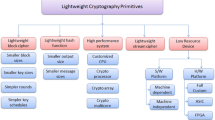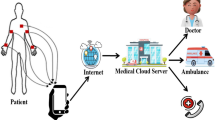Abstract
In this paper, a new joint multilevel data encryption and channel coding mechanism is proposed, which is called “multilevel/advanced encryption standard–systematic distance 4–continuous phase frequency shift keying” (ML/AES-SD4-CPFSK). In the proposed scheme, we have not only taken advantage of spatial diversity gains but also optimally allocated energy and bandwidth resources among sensor nodes as well as providing high level of security and error protection for cooperative communications in wireless sensor networks. Relay protocols of cooperative communications, such as amplify-and-forward and decode-and-forward with/without adversary nodes, have been studied for 4CPFSK, 8CPFSK, and 16CPFSK of ML/AES-SD4-CPFSK. We have evaluated the error performances of multilevel AES for data encryption, multilevel SD-4 for channel coding, and various CPFSK types for modulation utilizing cooperative communications in wireless sensor networks. According to computer simulation results, significant diversity gain and coding gain have been achieved. As an example, bit error rate (BER) performance of 10−5 value has been obtained at a signal-to-noise ratio (SNR) of −6 dB for SD-4-CPFSK scheme in a compared related journal paper, whereas in our proposed system, we have reached the same BER value at a SNR of −23 dB with amplify-and-forward with direct path signal protocol in 16-level AES, two-level SD-4 coded 16CPFSK, and at the same time, we have reached the same BER value at a SNR of −22 dB with amplify-and-forward without direct path signal protocol in 16-level AES, two-level SD-4 coded 16CPFSK.










Similar content being viewed by others
References
Hunter TE, Hedayat A (2004) Cooperative communication in wireless networks. IEEE Communications Magazine, pp 74–80
van der Meulen EC (1971) Three-terminal communication channels. Adv Appl Probab 3:121
Cover TM, Gamal AE (1979) Capacity theorems for the relay channel. IEEE Trans Inf Theory 25(5):572
Laneman JN (2002) Cooperative diversity in wireless networks: algorithms and architectures. PhD thesis, Massachusetts Institute of Technology
Islam MR, Kim J (2008) Channel estimated cooperative MIMO in wireless sensor networks. IETE Technical Review 25(5):234–243
Sendonaris A, Erkip E, Aazhang B (2003) User cooperation diversity. Part 1: system description. IEEE Trans Commun 51(11):1927–1938
Sendonaris A, Erkip E, Aazhang B (2003) User cooperation diversity. Part 2: implementation aspects and performance analysis. IEEE Trans Commun 51(11):1939–1948
Zhao B, Valenti MC (2003) Distributed turbo coded diversity for relay channel. IEE Electronics Letters 39(10):786–787
Berrou C, Glavieux A, Thitimajshima P (1993) Near Shannon limit error-correcting coding and decoding: turbo codes. Proceedings of the International Conference on Communications (ICC), pp 1064–1070
Daemen J, Rijmen V (2000) The block cipher Rijndael. Smart Card Research and Applications, LNCS 1820. Springer, Berlin, pp 288–296
Daemen J, Rijmen V (1999) AES proposal: Rijndael AES algorithm submission. September 3
Altay G (2008) Performance of systematic distance-4 binary linear block codes with continuous phase frequency shift keying over MIMO systems, wireless pers. Commun 44:403–413. doi:10.1007/s11277-007-9364-2
Ucan ON, Acarer T, Karacuha E, Osman O, Altay G, Yalcin Ş (2008) Performance of the systematic distance-4 codes over fading channels. Istanbul Univ J Electr Electron Eng 8(2):707–713
Rimoldi BE (1988) A decomposition approach to CPM. IEEE Trans Inform Theory 34:260–270
Laneman JN, Wornell GW, Tse DNC (2001) An efficient protocol for realizing cooperative diversity in wireless networks. Proceedings of IEEE International Symposium on Information Theory (ISIT ’01), Washington, USA, p 294
Sendonaris A, Erkip E, Aazhang B (1998) Increasing uplink capacity via user cooperation diversity. Proceedings of IEEE International Symposium on Information Theory (ISIT ’98), Cambridge, USA, p 156
Hunter TE, Nosratinia A (2006) Diversity through coded cooperation. IEEE Trans Wireless Commun 5(2):283–289
Laneman JN (2003) Distributed space–time coded protocols for exploiting cooperative diversity in wireless networks. IEEE Transactions on Information Theory 49(10):77–81
Nabar RU, Bölcskei H, Kneubühler FW (2004) Fading relay channels: performance limits and space–time signal design. IEEE J Select Areas Commun 22(6):1099–1109
Liu X, Su W (2007) BER performance analysis of the optimum ML receiver for decode-and-forward cooperative protocol. Proceedings of IEEE ICASSP, April 2007, pp 485–488
Su W, Sadek AK, Liu KJR (2008) Cooperative communication protocols in wireless networks: performance analysis and optimum power allocation. Wireless Pers Communication 44:181–217
Brennan DG (2003) Linear diversity combining techniques. Proc IEEE 19(2):331–356
FIPS 197 (2001) Advanced encryption standard, Federal Information Processing Standard (FIPS), Publication 197, National Bureau of Standards, U.S. Department of Commerce, Washington, DC
Hekim Y, Odabasioglu N, Ucan ON (2007) Performance of low density parity check coded continuous phase frequency shift keying (LDPCC-CPFSK) over fading channels. Int J Commun Syst 20:397–410
Author information
Authors and Affiliations
Corresponding author
Rights and permissions
About this article
Cite this article
Cam, H., Ozduran, V., Altay, G. et al. Cooperative communications with multilevel/AES-SD4-CPFSK in wireless sensor networks. Ann. Telecommun. 66, 507–518 (2011). https://doi.org/10.1007/s12243-010-0219-6
Received:
Accepted:
Published:
Issue Date:
DOI: https://doi.org/10.1007/s12243-010-0219-6




